iPhone 12 Pro Max vs. OnePlus 9 Pro
Pro bowl face-off: iPhone 12 Pro Max vs. OnePlus 9 Pro
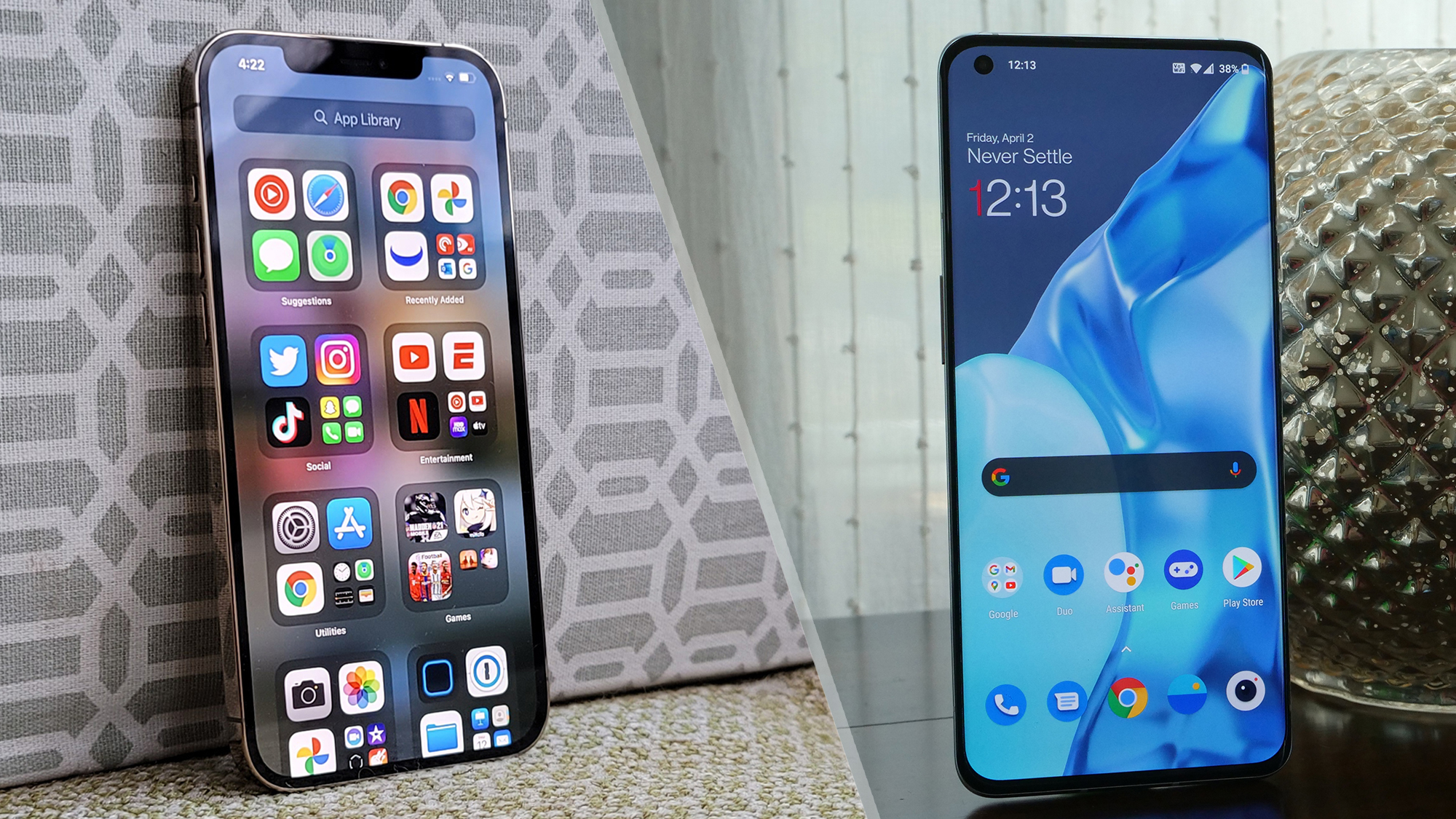
With the arrival of the OnePlus 9 Pro, there is finally another proper flagship Android phone that can do battle against the iPhone 12 Pro Max. OnePlus has gone from a scrappy budget underdog in the flagship market to producing hardware that is on a par with the best of the best.
That bump in quality comes with ever-rising prices; the OnePlus 9 Pro now starts at $969. It’s not a far cry from the $1,099 starting price for the iPhone 12 Pro Max. However, that still leaves OnePlus with a price advantage and, as you’ll see, there are some hardware benefits for the OnePlus 9 Pro that make it feel like a good value. And that’s before you consider the unbelievable fast charger that comes in the box.
- Best smartphones in 2021
- iPhone 13: Price, release date, specs and more
- Best mobile phone deals in April 2021
We’re going to look at the iPhone 12 Pro Max versus the OnePlus 9 Pro across seven different categories and determine a winner in each before we crown the overall winner and help you determine which phone is the right choice for you.
| Row 0 - Cell 0 | iPhone 12 Pro Max | OnePlus 9 Pro |
| Display (refresh rate) | 6.7-inch, OLED, Super Retina XDR (2,778 x 1,284, 60Hz) | 6.7-inch QHD AMOLED (3,216 x 1,440, 120Hz) |
| CPU | Apple A14 Bionic | Qualcomm Snapdragon 888 |
| RAM | 6GB | 8 or 12GB |
| Storage | Starts at 128GB | 128 or 256GB |
| Rear cameras | 12MP f/1.6 (Wide-angle), 12MP f/2.4 (ultra-wide), 12MP f/2.2 (Telephoto) | 48MP wide (ƒ/1.8); 50MP ultrawide (ƒ/2.2); 8MP telephoto (ƒ/2.0); 2MP monochrome |
| Front camera | 12MP, f/2.2, TrueDepth | 16MP, f/2.4 |
| Battery size | 3,867 mAh | 4,500 mAh |
| Water resistance | Yes, IP68 | Yes, IP68 |
| Colors | Graphite, Silver, Gold, Pacific Blue | Morning Mist or Pine Green |
| Dimensions | 6.3 x 3.1 x 0.29 inches | 6.4 x 2.9 x 0.34 inches |
| Weight | 8 ounces | 6.95 ounces |
iPhone 12 Pro Max vs. OnePlus 9 Pro: price and value
The iPhone 12 Pro Max starts at $1,099 for a 128GB model with 6GB of RAM. You can double your storage to 256GB for another $100, or for $1,399, you can have the maxed-out 512GB model we reviewed.
The OnePlus 9 Pro starts at a more affordable $969 for the 128GB model with 8GB of RAM. For $1,069, you can get the top-end model that bumps your storage up to 256GB and your RAM to 12GB.
It’s not the massive price advantage OnePlus flagships once had over the iPhone, but the OnePlus 9 Pro still has a not-so-insignificant $130 advantage over the iPhone 12 Pro Max. Comparing it to the iPhone 12 Pro brings the price gap down to a negligible $30, but given the tremendous display size disparity, that seems like a less apt comparison.
Winner: OnePlus 9 Pro
Sign up to receive The Snapshot, a free special dispatch from Laptop Mag, in your inbox.
iPhone 12 Pro Max vs. OnePlus 9 Pro: design
If you have read our reviews of both phones, you’re well aware of how this one is going to go, but let’s go over it anyway.
There’s no denying that the iPhone 12 Pro Max is an enormous phone. The squared-off redesign has the most visual impact on the largest iPhone 12 model. I still find the design striking, particularly on the gold model, and despite the edges, it’s quite comfortable to hold. For those who are put off by the edges, a case solves any potential problem. Pocketability is one issue that there isn’t getting around. The iPhone is impressively thin, but the lack of rounded edges makes it tougher to slip such a large device in and out of a pocket.
Curved displays are perceived as premium and from a visual standpoint, I get that. But in terms of usability, I prefer a flat display like that of the iPhone 12 Pro Max. Apple’s new “Ceramic Shield” display was just one of the phone’s durability enhancements this year. It also offers the best IP68 water and dust resistance that we’ve seen from a mainstream smartphone. Drop tests show they will still definitely break if they hit a hard surface — so I’d still recommend a case — but the increased durability is nice.

The OnePlus 9 Pro, by comparison, has a very safe design; it looks much like any number of other flagships released in recent years. The curved glass back, curved glass display and rounded edges make it a stark contrast to the hard edges of the iPhone 12 Pro Max. I find it slippery to handle, so for very different reasons, I recommend putting a case on the OnePlus 9 Pro as well.
This is particularly true if you opt for the Morning Mist color option which has a mirror-like finish that will be smudged instantly. If you prefer going caseless, opt for the Pine Green option and its beautiful matte finish. The Hasselblad-branded rear camera array now resembles that of most other flagships as well, with OnePlus shifting to a rectangular arrangement in the upper-left corner. The phone’s IP68 protection isn’t quite equal to the iPhone, but water and dust incursion won’t be a problem. And it features a Gorilla Glass Victus display that should be roughly comparable to the iPhone's Ceramic Shield in terms of durability.
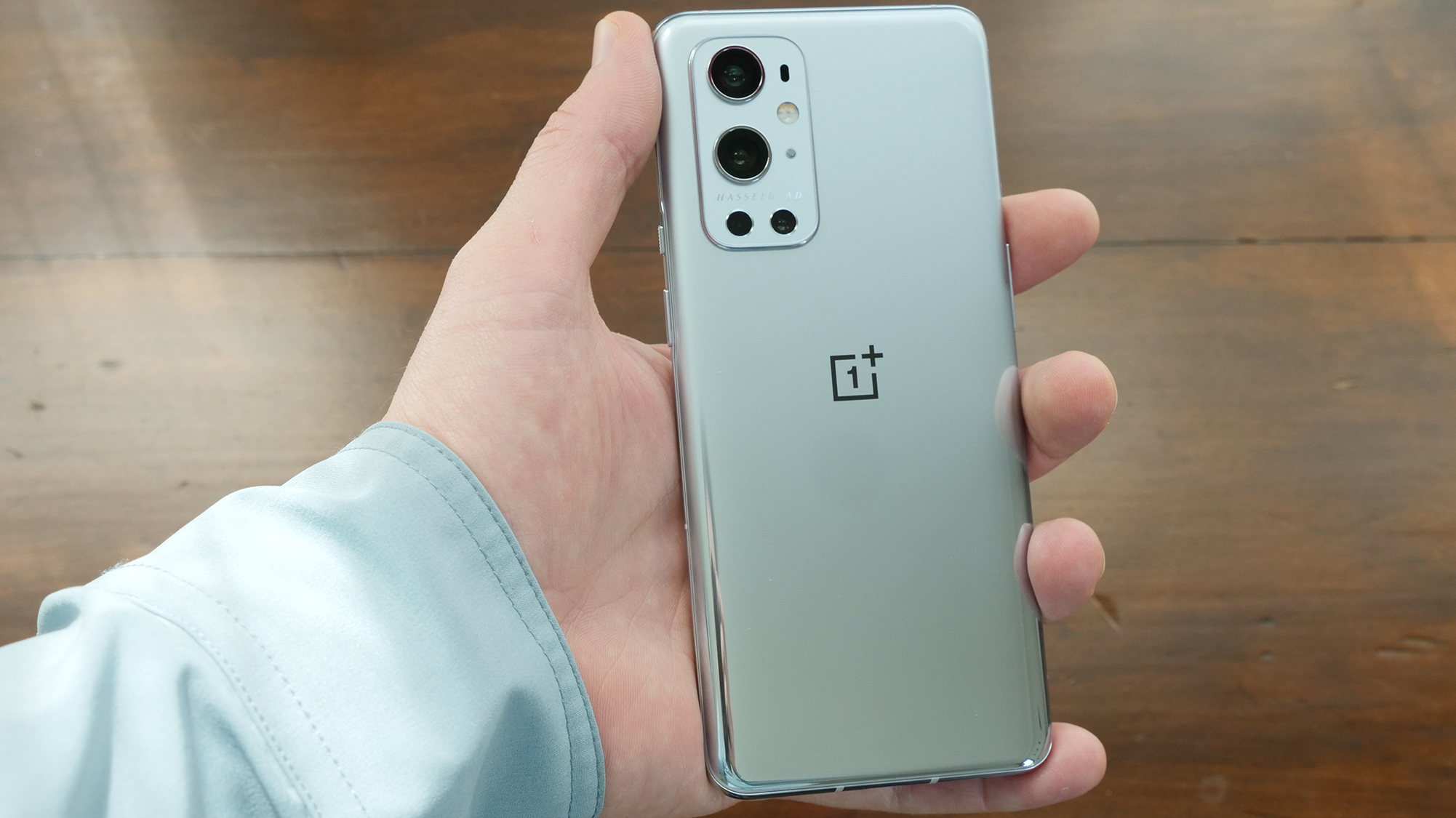
Turning to the size of the phones, the iPhone 12 Pro Max (6.3 x 3.1 x 0.29 inches) is the smaller of the two in height and depth, while the OnePlus 9 Pro (6.4 x 3 x 0.31 inches) is a bit narrower. The differences feel pretty negligible in practice. The slight difference in height versus width makes both reasonably usable with one hand although the rounded edges of the OnePlus 9 Pro make it feel thinner than the iPhone 12 Pro Max. Despite being slightly smaller, the iPhone 12 Pro Max is the heavier of the two phones at 8 ounces versus 7.1 ounces. This isn’t surprising given the boxy design.
Overall, the iPhone 12 Pro Max is the easy winner here. Not only from an aesthetic standpoint, where the iPhone is instantly recognizable for its unique design, but because of its durability and usability due to the flat display.
Winner: iPhone 12 Pro Max
iPhone 12 Pro Max vs. OnePlus 9 Pro: display
The iPhone 12 Pro Max features a 6.7-inch, Super Retina XDR OLED display with a 2,778 x 1,284-pixel resolution. The OnePlus 9 Pro matches it in size at 6.7 inches, but beats it in every other regard with a QHD (3216 x 1440) resolution for the AMOLED panel with a 120Hz adaptive refresh rate that can drop all the way down to 1Hz when viewing static content.
When it comes to viewing content, whether that’s a video, photo or a game, both of the displays offer a vivid and crisp image. HDR content, in particular, shines with solid support on each of the phones.
Placing them side-by-side to get a clearer picture of the differences, I turned to Our Planet on Netflix and was surprised by the disparity. The OnePlus 9 Pro delivers far more color accuracy than the iPhone 12 Pro Max; a jungle scene depicts it well with the iPhone introducing a warm (yellow) tone to the image that shouldn’t be there. This tinges everything from the sky in the background, which should be a light blue, to the white fur on the lemur. The iPhone (left) does give more even lighting that brings out some additional detail, most notably on the pink leaves of the tree and in the lemur’s eyes, but I’m not convinced this was intended in this HDR video.

Regardless of where you fall on the color reproduction, the OnePlus 9 Pro has one massive advantage over the iPhone 12 Pro Max: its adaptive refresh rate. The OnePlus 9 Pro can range from 1Hz all the way up to 120Hz based on what is playing on-screen, while the iPhone 12 Pro Max is locked at 60Hz. I’ll listen to those who argue that the difference between 90Hz and 120Hz is hard to perceive, but the difference between 60Hz and 120Hz is glaring.
The iPhone’s smooth animations and performance compared to Android have always been an advantage for Apple, but for the time being, that is gone. While Apple delivers the smoothest experience with a 60Hz panel of any manufacturer, there is simply no arguing that the 120hz display on the OnePlus 9 Pro is superior when navigating the OS and in any app that supports it.
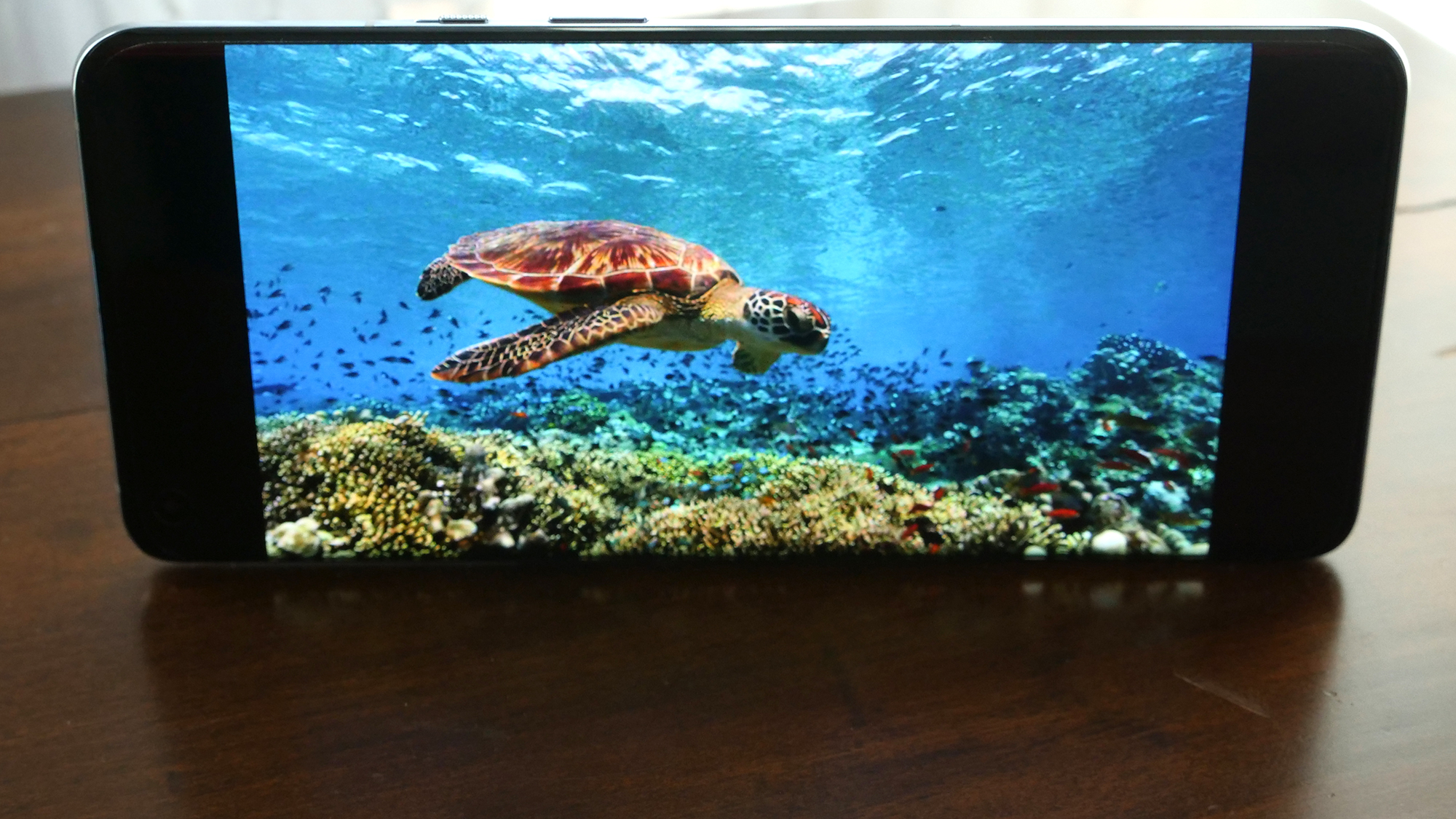
Moving to the colorimeter results, the iPhone 12 Pro Max covers 84.8% of the DCI-P3 color gamut with the OnePlus 9 Pro outperforming it considerably at 147.4%. For those who find that look to be too saturated, the OnePlus 9 Pro also lets you do quite a bit more fine-tuning with its natural setting bringing color coverage down to 84.9%.
Brightness is another win for the OnePlus 9 Pro, at 722 nits, compared to 654 nits for the iPhone 12 Pro Max. This shouldn’t tip the scales for anyone though because both screens are bright enough for even the sunniest of days.
This category isn’t close; the iPhone 13 is heavily rumored to include an LTPO panel like that found on the OnePlus 9 Pro, and Apple definitely needs this to be competitive in the display category again.
Winner: OnePlus 9 Pro
iPhone 12 Pro Max vs. OnePlus 9 Pro: performance
The OnePlus 9 Pro comes closer than any other Android phone to the performance of the iPhone 12 Pro Max, but the A14 Bionic still easily reigns supreme over the Snapdragon 888, even when the Qualcomm chip is paired with double the RAM of the iPhone 12 Pro Max. With that said, here’s a more thorough breakdown of what that looks like in practice.
There is no current task or game that will bring either phone to a halt or even slow them down noticeably. In my review of each, I loaded up dozens of Google Chrome tabs, apps, picture-in-picture videos and games, and there’s nothing they couldn’t handle. That is likely to remain the case with the iPhone 12 Pro Max for at least another two years, which is also when I imagine Qualcomm will manage to catch up to the performance of the A14 Bionic.

On the Geekbench 5 overall performance test, the iPhone 12 Pro Max achieved a score of 4,111, which is second only to the iPhone 12 mini. The OnePlus 9 Pro is, at present, the fastest Android phone on the market and managed a score of 3,685, slightly outperforming the iPhone 12 Pro (3,669). Graphics-focused testing shows where Apple has a greater advantage; the Wild Life Unlimited 3DMark test was not bad for the OnePlus 9 Pro, which managed 35 frames per section, but the iPhone 12 Pro outclassed it by more than 50% with 54 frames per second.
The Adobe Premiere Rush video editing test drove Apple’s real-world performance advantage further; the iPhone 12 Pro Max finished rendering and exporting a 4K video to 1080p in just 28.5 seconds. The same task took the OnePlus 9 Pro 1 minute and 3 seconds.
For most consumers, the difference in performance today is not going to be that perceptible, but there is no question that the iPhone 12 Pro Max is the more powerful phone.
Winner: iPhone 12 Pro Max
iPhone 12 Pro Max vs. OnePlus 9 Pro: battery life and charging
The iPhone 12 Pro Max was the only iPhone 12 that managed to shake the battery life complaints aimed at the rest of the lineup. You will still need to pick up a charger since Apple dropped that from the box, but you can take that chance to buy a fast iPhone 12 charger.
The OnePlus 9 Pro puts more shame on Apple in this regard than any other phone with a 65W fast charger included in the box. That charger can bring the OnePlus 9 Pro from dead to a full charge in about 30 minutes compared to a 47% charge in that same amount of time using the 20W fast charger available from Apple with the iPhone 12 Pro Max.
Turning to our testing, which involves continuous web surfing at 150 nits of brightness, the iPhone 12 Pro Max made it 10 hours and 53 minutes compared to 11:44 for the OnePlus 9 Pro. What’s most impressive is that this result was achieved on its Smart 120Hz mode. When we tested it locked to its 60Hz mode, the battery dropped to 10:29, so don’t give up that high refresh rate looking for more battery life. With the iPhone 12 Pro Max, you could get another hour or so if you disable 5G, which would even things out although doing so on the OnePlus 9 Pro would have a similar effect.
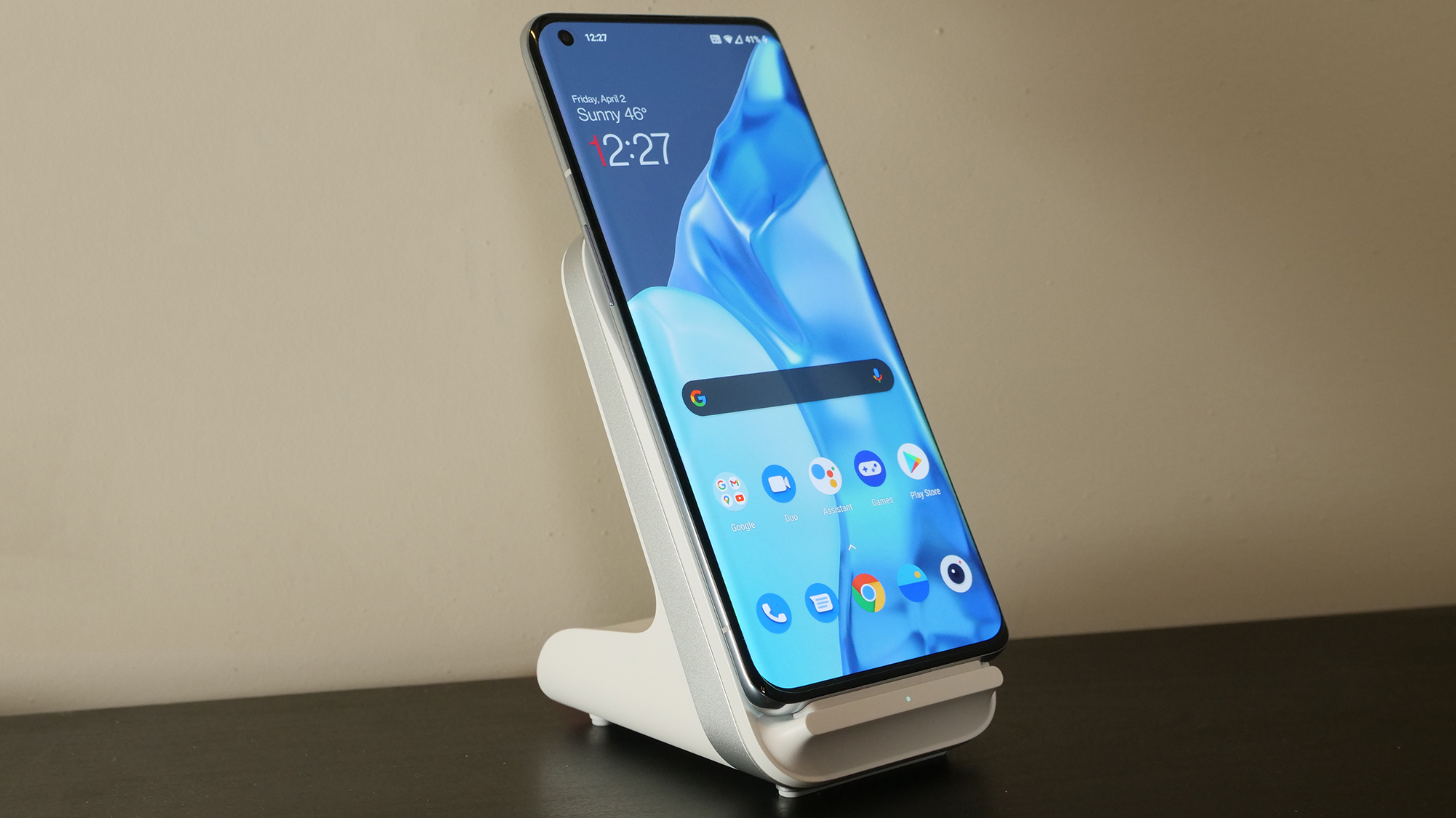
Both smartphones support wireless charging with Qi-compatible chargers, but as with wired charging, the OnePlus 9 Pro supports dramatically higher wireless charging speeds of 50W. This requires the amazing Warp Charge 50 wireless charger from OnePlus. The iPhone 12 Pro Max, for its part, offers the new MagSafe wireless charging. This is a combination of Qi and a circular magnet located on the back of the iPhone. The MagSafe charger is available for $39 from Apple. I’ve been disappointed in the 3rd-party MagSafe offerings we’ve seen so far, but more are definitely coming.
There’s no contest here; the OnePlus 9 Pro offers better battery life and the 65W fast charging and 50W wireless charging are absolutely game-changing features. If you have even 10 minutes to charge, you can get to about a 50% charge. Coupled with solid battery life, the charging speeds renders battery life concerns a thing of the past.
Winner: OnePlus 9 Pro
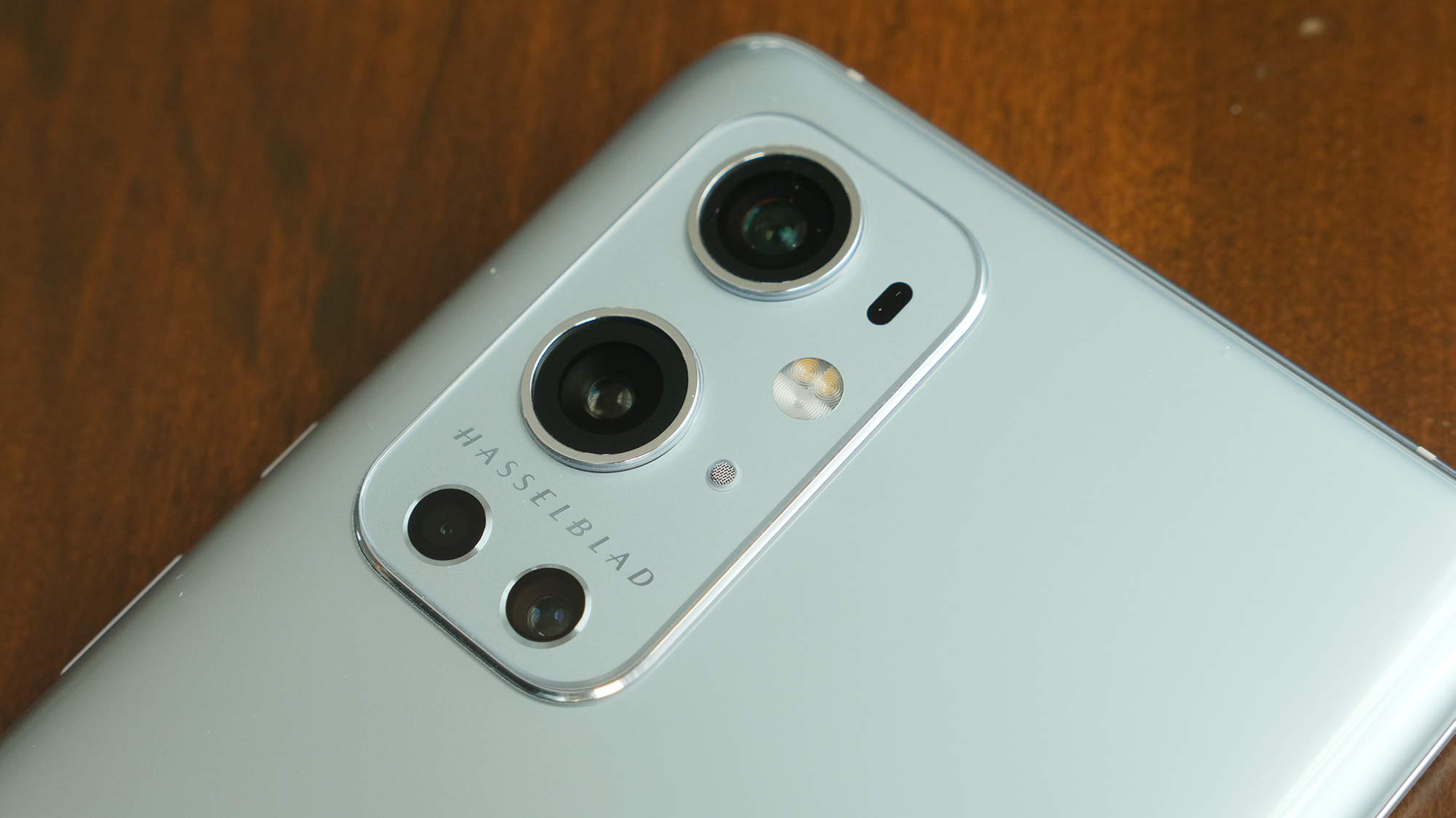
iPhone 12 Pro Max vs. OnePlus 9 Pro: cameras
The basic camera setup on both of these phones is quite similar, with a wide-angle, ultra-wide and telephoto on the back and a single front-facing camera. The iPhone 12 Pro Max adds its LiDAR scanner and TrueDepth sensor, which give it some enhanced depth sensing and AR features. Meanwhile, the OnePlus 9 Pro uses a laser autofocus system and adds a fourth monochrome sensor on the back that serves to enhance photos taken from the other lenses.
The iPhone 12 Pro Max is nothing if not predictable when it comes to megapixel count, with all four of its cameras coming in at 12MP. The wide-angle is one of the fastest we’ve seen at f/1.6 while the ultra-wide is the slowest at f/2.4 and the telephoto and front-facing both come in at f/2.2.
The OnePlus 9 Pro features a new 48MP Sony IMX789 sensor for its main wide-angle sensor at f/1.8, a 50MP Sony IMX766 ultra-wide sensor at f/2.2, an 8MP 3.3x telephoto at f/2.4, and the 2MP monochrome camera. However, the hardware has not been the primary focus with the OnePlus 9 Pro. Much more attention has been lavished on the company’s partnership with famed camera maker Hasselblad. While this should have hardware implications down the road, the impact for the OnePlus 9 Pro is purely around the color science and the camera app itself.
You will be happy with the results from either camera when you're simply snapping daytime shots. The iPhone 12 Pro Max offers a more toned-down and natural look, but the OnePlus 9 Pro doesn’t push things to the surreal levels of a Samsung phone. With that said, I typically prefer the colors out of the OnePlus 9 Pro. White balance in several of the shots on the iPhone is completely off and throws the whole scene for me. The ultra-wide splits things a bit for me; there, the iPhone gives a better image overall, but it does fall victim to the edge distortion that the OnePlus 9 Pro avoids. You can, of course, make your own determinations regarding the images, so here’s a look at a collection of shots from the iPhone 12 Pro Max.

iPhone 12 Pro Max - Ultra-wide

iPhone 12 Pro Max - Wide-angle

iPhone 12 Pro Max - Telephoto

iPhone 12 Pro Max - Wide-angle

iPhone 12 Pro Max - Telephoto

iPhone 12 Pro Max - Ultra-wide

iPhone 12 Pro Max - Wide-angle

iPhone 12 Pro Max - Telephoto

iPhone 12 Pro Max - Telephoto (10x Zoom)
And here are the same photos captured with the OnePlus 9 Pro. While compressed for online use, the telephoto photos from the OnePlus 9 Pro look alright. It’s a definite weak spot. I would recommend that you stick to the primary lens then crop in, which is not a problem with its 48MP resolution.

OnePlus 9 Pro - Ultra-wide angle

OnePlus 9 Pro - Wide-angle

OnePlus 9 Pro - Telephoto

OnePlus 9 Pro - Wide-angle

OnePlus 9 Pro - Telephoto

OnePlus 9 Pro - Ultra-wide

OnePlus 9 Pro - Wide-angle

OnePlus 9 Pro - Telephoto

OnePlus 9 Pro - Telephoto (10x Zoom)
Portraits, both from the front-facing and rear cameras, are a different matter entirely. The iPhone 12 Pro Max uses its LiDAR sensor and True Depth sensors to its full advantage, doing a much better job of detecting edges depth. Depending on the subject, the OnePlus 9 Pro does fine, but it is more apparent that this is a software effect being tacked on. Here’s a look at some portrait photos with both lenses from the iPhone 12 Pro Max.
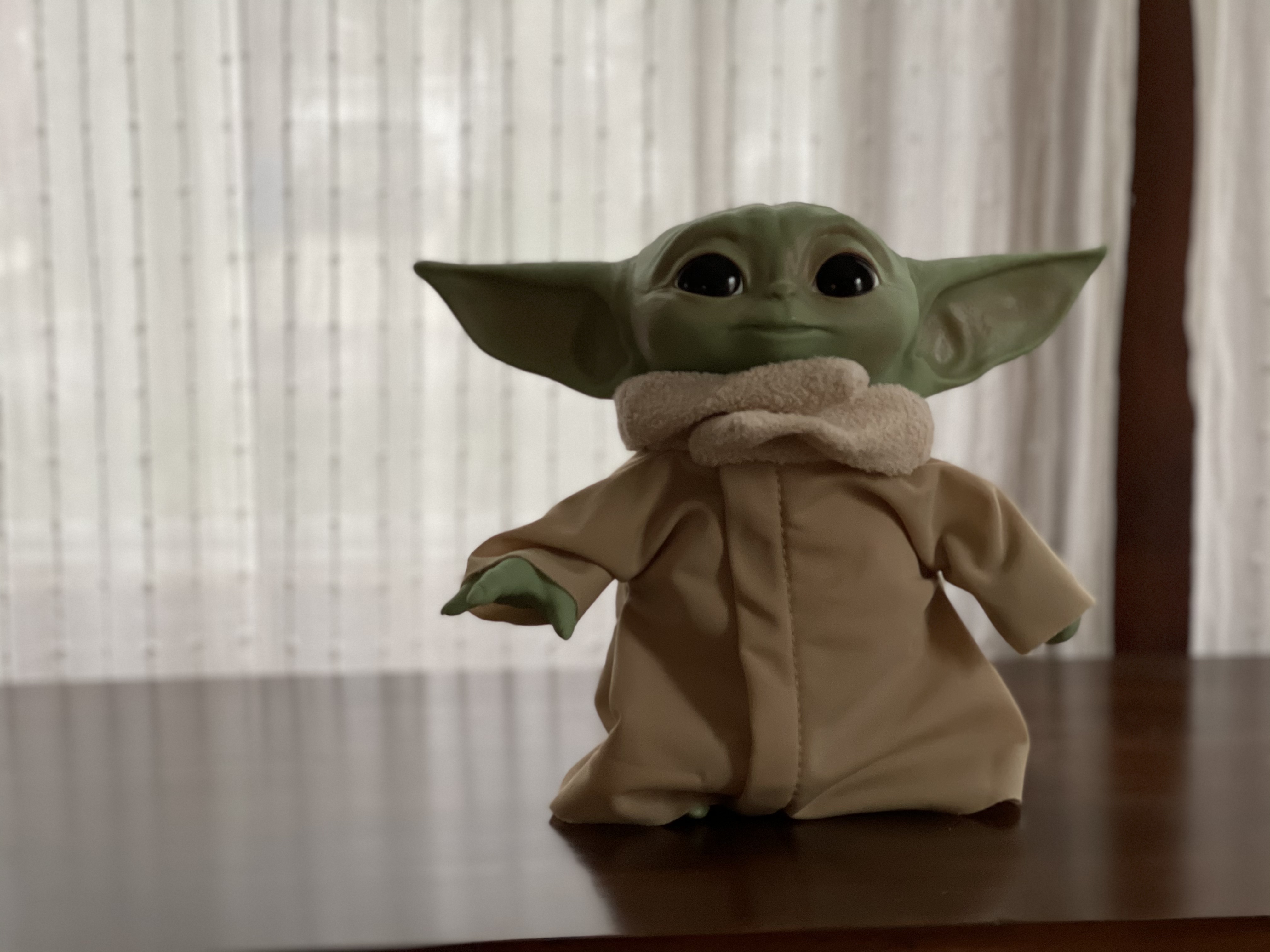
iPhone 12 Pro Max - Portrait mode

iPhone 12 Pro Max - Portrait mode

iPhone 12 Pro Max - Portrait mode (front-facing camera)
And then here are the same photos with the OnePlus 9 Pro.
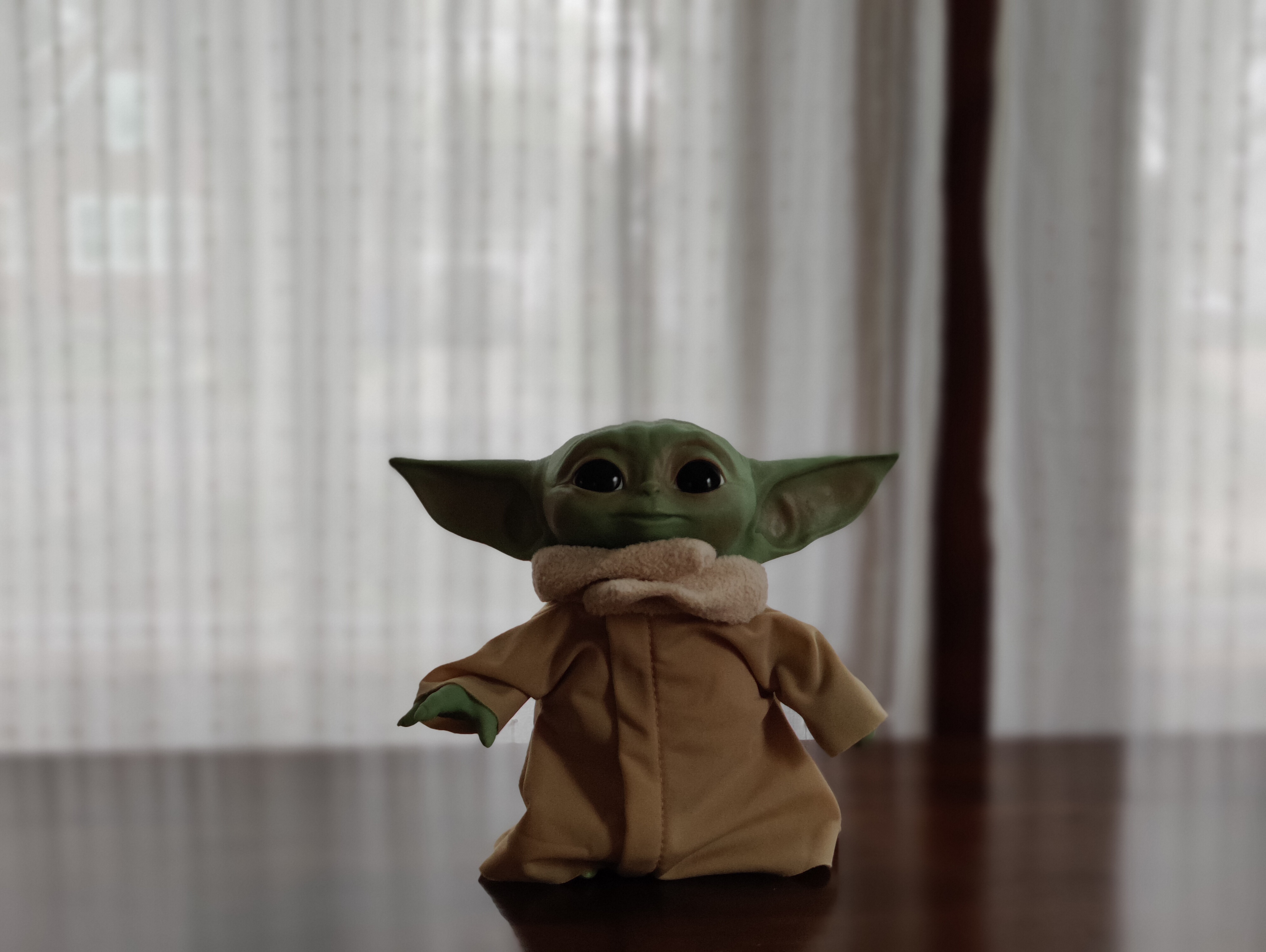
OnePlus 9 Pro - Portrait mode
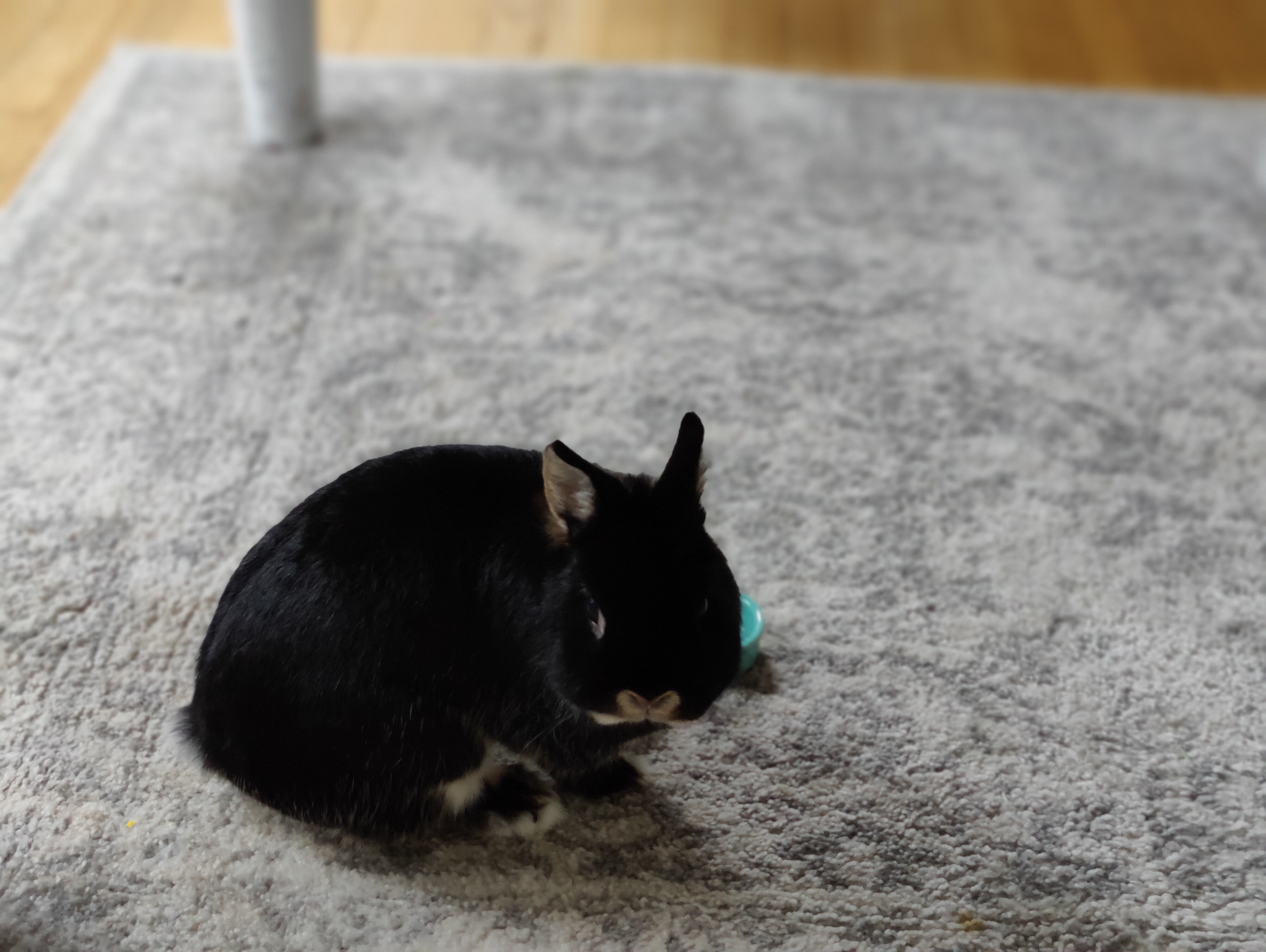
OnePlus 9 Pro - Portrait mode

OnePlus 9 Pro - Portrait mode (front-facing camera)
I’m not unhappy with any of them and I do still have my preference for the colors in the OnePlus 9 Pro shots, but the iPhone wins when looking specifically at the portrait mode quality.
One other detail I noted when going through my entire set of photos is that I encountered slightly more “missed” photos with the OnePlus 9 Pro. This was typically just a matter of the focus being slightly off, but I suspect this was often a result of its slower lens versus the iPhone 12 Pro Max. It wasn’t a frequent error and only occurred with moving subjects, but it’s worth considering if you are regularly snapping photos of your children or animals or anything that won't sit still.
Overall, I’m calling the cameras a draw; there are distinct areas where I dramatically prefer one to the other and I’m not comfortable saying that one comes out clearly on top. If you are taking mostly portraits — whether of yourself or others — the iPhone is the clear winner. The same is true if you have twitchy or fast-moving subjects. However, I have a preference for the colors coming out of the OnePlus 9 Pro. It is just the right mashup of natural with a minor pop applied that yields something closer to what I see when I am taking the shot.
Winner: Draw

iPhone 12 Pro Max vs. OnePlus 9 Pro: software
As always, I am not interested in a discussion of the relative merits of iOS versus Android as both have their advantages and disadvantages. If you have only ever used one or the other then it can certainly feel like they are miles apart, but given a week or two, most would quickly adapt and find there are far more similarities than differences.
But I digress. What I do find compelling is the software support available between the two devices and, in this regard, the iPhone 12 Pro Max wins by a considerable margin.
Apple offers roughly 5 to 6 years of support for its flagship phones. The current speculation is that the iPhone 6S and 6S Plus along with the original iPhone SE (2016) will lose support with iOS 15, which will have been 6 years and 5.5 years of updates, respectively, for those devices. It's reasonable to assume something similar for the iPhone 12 Pro Max.
The OnePlus 9 Pro, by comparison, is only promised two major Android updates, meaning that it will be EOL as far as feature updates in late 2022 while iPhone 12 Pro Max owners can expect updates into 2026.
Winner: iPhone 12 Pro Max
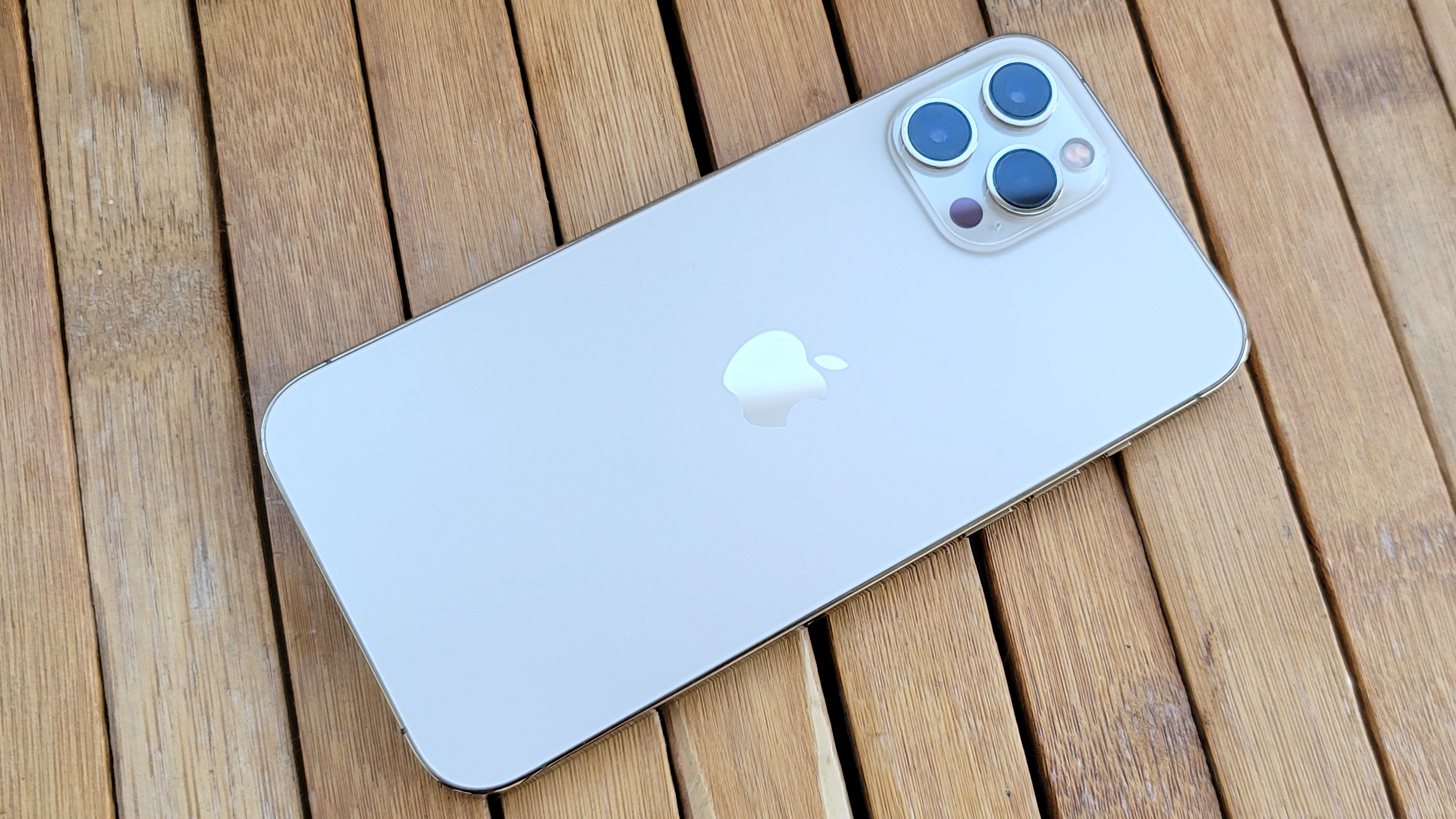
Overall winner: iPhone 12 Pro Max
The iPhone 12 Pro Max claims another win, but this was very close. Ultimately, a few features that fall in favor of the iPhone can’t be dismissed.
Software support is chief among these, with Apple offering roughly four extra years of full software support. That is massive when you consider the price you are paying for these phones. And critically, given the unbelievable performance you get out of the iPhone 12 Pro Max, it should still be going strong in 2026. The display is probably the biggest weak spot for the iPhone; it isn’t bad, but it's simply not up to the caliber of the OnePlus 9 Pro.
The OnePlus 9 Pro, by comparison, offers a number of features that just dramatically outclass the iPhone 12 Pro Max, including the aforementioned 120Hz adaptive display, its otherworldly fast charging with the included 65W charger, and the $150 of savings when you factor in the charger. Software support is where it really falls down for me. Two years just isn’t enough for a flagship in 2021. While the phone will hardly fall apart when it stops receiving major Android OS updates, the limited support is disappointing.
To be clear, neither phone is a bad choice. If you have a strong preference between iOS and Android, let that be your guide. But ultimately, the iPhone 12 Pro Max is the better phone for most people.
Sean Riley has been covering tech professionally for over a decade now. Most of that time was as a freelancer covering varied topics including phones, wearables, tablets, smart home devices, laptops, AR, VR, mobile payments, fintech, and more. Sean is the resident mobile expert at Laptop Mag, specializing in phones and wearables, you'll find plenty of news, reviews, how-to, and opinion pieces on these subjects from him here. But Laptop Mag has also proven a perfect fit for that broad range of interests with reviews and news on the latest laptops, VR games, and computer accessories along with coverage on everything from NFTs to cybersecurity and more.

